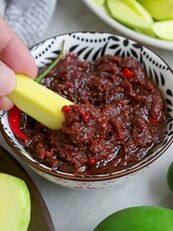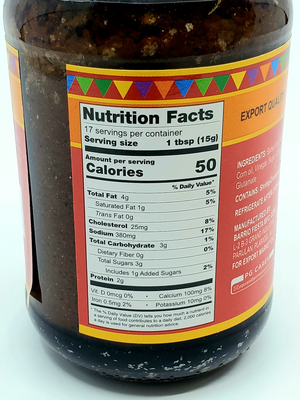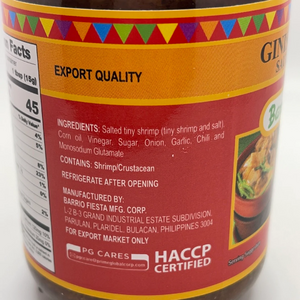Course:FNH200/Projects/2022/Bagoong
Introduction

Bagoong [buh-goh-ong] is a Filipino dish that is made from fish or shrimp paste. The fish used in the making process of Bagoong includes anchovies, sardines, herring, silverside, shrimp, slipmouth, freshwater porgy, oysters, clams, and other shellfish. Bagoong is characterized as reddish brown and salty with a cheese-like odor. Bagoong goes through a fermentation process that involves salt and slow digestion, which breaks down into liquid and solid forms [1]. The solid material is later called bagoong, while the liquid form is further fermented to form another condiment called patis or fish sauce. Bagoong is not the only fish paste product that exists; this type of fish/shrimp fermentation exists throughout Southeast Asia. Similar products to bagoong include belachan in Malaysia, trassi in Indonesia, nam-ca in Vietnam, kapi in Thailand, and ngapi in Burma [1].
Brief History

Bagoong is a traditional dish of the Philippines where fish or shrimp is fermented along with salt and is then created into a paste. While Bagoong itself originated in the Philippines, the process of fermenting fish has existed since the Greco-Roman era. As defined by Pliny the Elder, Garum is “a choice liquor consisting of the guts of fish and the other parts that would otherwise be considered refuse” [2]. Later on, fermented fish sauce also appeared in the Middle East under the moniker Mahyawa and was served in the “southern coastal regions of Iran”[3]. Finally, Bagoong itself originated in the eighth century in Thailand, where shrimp was first dried out and fermented. From there, it spread out to the surrounding countries and finally to the Philippines. Mentions of Bagoong range in western media range back to the 17th century when British explorer, William Harper, mentions encountering Bagoong in his book “A New Voyage Round the World”. Many different variations of Bagoong can be found all across the Phillipines, such as the Bagoong Balayang, Terong, Alamang, Isda, and Ginamos. Each of these Bagoong's relate to the different form of seafoods utilised within the recipe itself as fish ranging from anchovies to silverperch can be used in the creation.[4] While many variations of the dish exist, the main Bagoongs are Isda and Alamang. Bagoong Alamang is made from shrimp and krill which is fermented and made into a paste while Bagoong Isda is made from anchovies.
Production of Bagoong
Fermentation
Bagoong is a Filipino dish which is made from fish paste. There are several types of fishes that can be used to produce bagoong. For instance, anchovies, shrimp, oysters, clams, herring, and many other shellfish could be used. The most common type of fish used in bagoong are anchovies. This paste is specially known as a Filipino condiment that can be eaten raw or cooked in many Filipino traditional recipes. Some examples are served as a dip for green mangoes or to mix with salad. There are some variations of how bagoong is produced. The most famous two types of bagoongs are isda and alamang. Bagoong isda is made of fermented fish and salt, meanwhile bagoong alamang is made of krill or shrimp paste with salt [5]. The Fermentation process alone is insufficient to preserve the product, instead it helps in the development of a distinctive flavour in the final product for which the Bagoong is famous for [6]. Fermentation combined with drying and salting preserves the fish or shrimp used in the product. Moreover, it is significant to remember that bagoong is the partially digested fish or shrimp residue that has not yet been absorbed (partially hydrolized). The final product smells similar to cheese and is salty [7].
The first step in making Bagoong Isda (bagoong made with fish) is to select the preferred type of fish. The fish is then cleaned thoroughly and drained well. The fermentation process usually begins with salting and drying the fish. Depending on the weight of the preparation, salt is diluted with the drained samples in ratios ranging from 1:3 to 2:7. The addition of salt lowers the water activity of the product, eliminating the growth process of seaweed, proteolytic and putrefying bacteria [6].
The process takes three months to one year to complete. As more fermentation results in more breakdown of fish’s skin and muscle, aroma and taste can be enhanced by allowing the fish to ferment for up to a year [6]. However, the fermentation mixture is stirred occasionally to make evenly distribute the salt within the solution. This is done to enhance the aroma and taste constituents and more importantly, to saturate the fish and prevent spoilage of fish during the long fermentation hours.
Fermentation Factors and Bacteria Involved
One of the main factors in bagoong fermentation is salt. Depending on the size of the bagoong production, the amount of salt varies – usually 11% to 25%. As studied in class lecture, salt is a crucial solute that attracts free water, allowing chemical reactions in food. In the fermentation of bagoong, dissolved salt in the water draws water from fish or shrimp cells. This process also brings other solutes and the bacteria, like gram-negative bacteria, commonly found bacteria at the initial state of fermentation [1]. These bacteria are sensitive to hypertonic conditions, which refers to a situation where freshwater leaves cells membrane to attract salt solute. According to the National Research Council (US) Panel on the Applications of Biotechnology to Traditional Fermented Foods (1992), some good and bad microorganisms can still be found in Bagoong [8].
Some good microorganisms like fish intestine enzyme, bacillus subtilis, and bacillus coagulans are responsible for the protein hydrolysis process. This process helps make the protein more soluble and digestible. These enzymes then further break down amides and amino acids to form the product’s flavor.[9] Bacillus pumilus is a commonly found bacteria throughout the bagoong fermentation process.
Due to fermentation, the population of bacteria fluctuates throughout. Below are bacteria that can be found at the initial state of the fermentation:
- Bacillus coagulans
- Bacillus megaterium
- Bacillus subtilis
At the later stage, some bacteria that remain are:
- Bacillus licheniformis
- Micrococcus colpogenes
- Micrococcus roseus
- Micrococcus varians
- Staphylococcus’s species
Packaging and Storage
Proper packaging plays a key role in food safety, maintaining the nutrients, protecting it from physical damage and microbiological contamination. For instance, Bagoong’s packaging should be processed and packed under hygienic conditions and comply with the microbial levels set by the Bureau of Foods and Drugs [10]. This product in particular must be packed in containers made of glass, earthware, or wooden barrels. The use of tin cans may also be permitted provided that they are new and clean. Tin cans are not allowed to be used more than once as bagoong containers, this is to prevent contamination [7].
The nutritional components and potential risks of every packaging type must be observed and documented. The ideal container for bagoong must be air-tight. This allows the development and maintenance of the anaerobic conditions required for good fermentation and storage [10].
| Brand | Packaging Material |
|---|---|
| Barrio Fiesta | Glass Jar |
| Buenas | Glass Jar |
| Bulacan | Glass Jar |
| Dagupan | Glass Jar |
| Gizelle's | Glass Jar |
| Ilocano Branch | Glass Jar |
| JE'S | Tin Can |
| Kamayan | Glass Jar |
| Kapuso | Glass Jar |
| Lingayen | Glass Jar |
| Marisco | Glass Jar |
| Monika | Glass Jar |
Table 1 shows 12 bagoong companies. As can be seen, 11 out of 12 companies use glass jars as packaging material, and the remaining uses tin cans to package their product. Although clean earthenware and wooden barrels are permitted to store bagoong, Table 1 suggests that these materials are not used by present-day bagoong companies.
The preference for glass as a packaging material is attributed to glass' ability to resist chemical reactions, as a result of the natural materials that make up glass: sand, soda ash, and sandstone[11]. The combination of these leads to a non-porous material, preventing absorption of food, liquids, or gases[12]. This prevents unwanted and potentially dangerous chemical interactions such as deterioration of polymer-based materials (plastics)[13]; the non-reacting characterisic of glass helps ensures that product quality and taste are unaffected[14]. Glass is also resistant to corrosion, making it ideal for storing bagoong, as bagoong's slightly acidic and highly-salted nature[15] encourages corrosion.
Bagoong is naturally stable at room temperature, hence it can be left on the kitchen shelf. Since bagoong is already preserved, it doesn’t have to be refrigerated. As long as it is stored in an airtight container in a dry place, it will last long without being refrigerated. However, if bagoong is not consumed very often it might be better to store it in the refrigerator after opening. To prevent cross-contamination try to use a clean spoon, tightly close the jar or bottle after every use, and do not return uneaten portions to the container [16].
Food Components and Nutritional Labelling
| Food Component | Content (%) |
|---|---|
| Carbohydrates | 4.90 to 32.48 |
| Fat | 1.41 to 3.67 |
| Protein | 29.44 to 53.17 |
| Water | 33.79 to 52.54 |
A study of 11 bagoong brands obtained the data in Table 3. Although brands varied depending on processing, proximate composition determined bagoong's main component to be protein. Thus, bagoong could theoretically help with fulfilling daily suggested protein needs. However, it should be noted that it's high sodium content, as shown in Table 5, renders bagoong harmful if consumed in too often and in larger amounts. Carbohydrate and fat contents of bagoong are relatively low enough that they could be disregarded when making consumer decisions. The relatively higher water content is due to the liquid, mushy consistency of the product as a result of the fermentation process.
Potential final exam question
- What microorganism is used to ferment Bagoong and why does salt has a very important role?
- Lactic Acid Bacteria with mould, and salt reduces the water-activity. (correct)
- Yeast, and salt inhibits the growth of yeast
- Yeast with Lactic Acid Bacteria, and salt for flavouring
- Mould, and salt ensures the production of bateria
The answer is Lactic Acid Bacteria with mould, and salt reduces the water-activity.
This question should be on the final exam because it makes students apply what they have learnt in the fermentation chapter to determine which one of the microorganisms used in this specific fermentation of fish is Asia, which is Lactic Acid bacteria with mould. It also provides an understanding of how salt is used in the fermentation process.
References
- ↑ 1.0 1.1 1.2 Sanchez, Priscilla (1999). "Microorganisms and technology of Philippine fermented foods". Japanese Journal of Lactic Acid Bacteria: 19–28.
- ↑ Tonon, Rafael. "Everything You Ever Wanted to Know About Garum". Eater. Retrieved August 9, 2022.
- ↑ "Mahyawa".
- ↑ Tiglao, Getsy. ""Pinkabet', 'bagoong', and the Greco-Roman Legacy".
- ↑ Gregorio, A. (2015). "What is Bagoong Alamang?". Panlasang Pinoy. Retrieved August 10, 2022.
- ↑ 6.0 6.1 6.2 Arquillano, Nova E. "Profiling of Bagoong Production" (PDF). Retrieved August 11, 2022.
- ↑ 7.0 7.1 "Small-scale processing of fish". Community Development Library. 1982. Retrieved August 9, 2022.
- ↑ National Research Council (US) Panel on the Applications of Biotechnology to Traditional Fermented Foods (1992). "Applications of Biotechnology to Fermented Foods: Report of an Ad Hoc Panel of the Board on Science and Technology for International Development". Washington (DC): National Academies Press (US).
|chapter=ignored (help) - ↑ E. M. Barampouti et al, "CHAPTER 3 - status and perspectives of agricultural residues in a circular and resource-efficient context," in Clean Energy and Resources RecoveryAnonymous Elsevier Inc, 2021, pp. 49-102.
- ↑ 10.0 10.1 Sanchez, Priscilla C. (2013). "Philippine Fermented Foods: Principles and Technology". Retrieved August 10, 2022.
- ↑ Glass Alliance Europe. "What is Glass"". Glass Alliance Europe. Retrieved August 11, 2022.
- ↑ FEVE. "How does glass help preserve the taste of products?". The European Container Glass Federation. Retrieved August 11, 2022.
- ↑ Hotchkiss JH. Food-packaging interactions influencing quality and safety. Food Addit Contam. 1997 Aug-Oct;14(6-7):601-7. doi: 10.1080/02652039709374572. PMID: 9373524.
- ↑ Schrenk, Dieter (April 2014). "Literature report on food packaging materials and their potential impact on human health" (PDF). Retrieved August 11, 2022. line feed character in
|title=at position 50 (help) - ↑ Pilapil AR, Neyrinck E, Deloof D, Bekaert K, Robbens J, Raes K. Chemical quality assessment of traditional salt-fermented shrimp paste from Northern Mindanao, Philippines. J Sci Food Agric. 2016 Feb;96(3):933-8. doi: 10.1002/jsfa.7167. Epub 2015 Mar 30. PMID: 25762369.
- ↑ Miranda, Roselle (2022). "How To Store Bagoong". Yummy.ph. Retrieved August 10, 2022.
- ↑ Pongsetkul, J., Benjakul, S., Sampavapol, P. et al. Chemical composition and physical properties of salted shrimp paste (Kapi) produced in Thailand. Int Aquat Res 6, 155–166 (2014). https://doi.org/10.1007/s40071-014-0076-4

